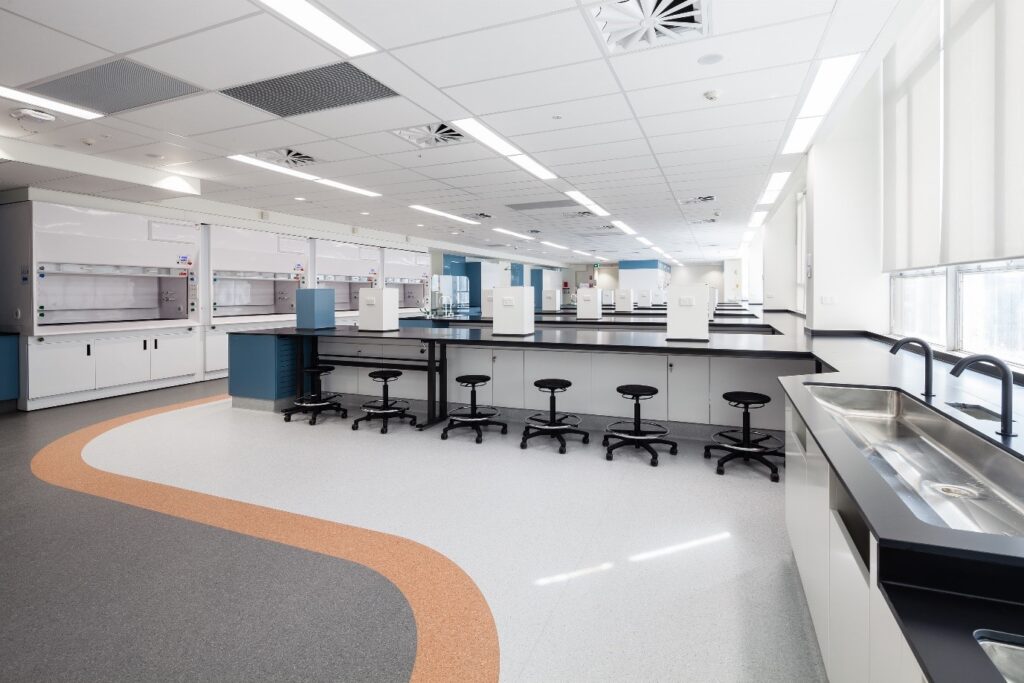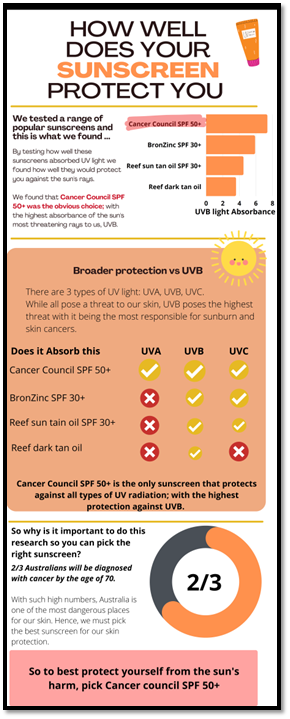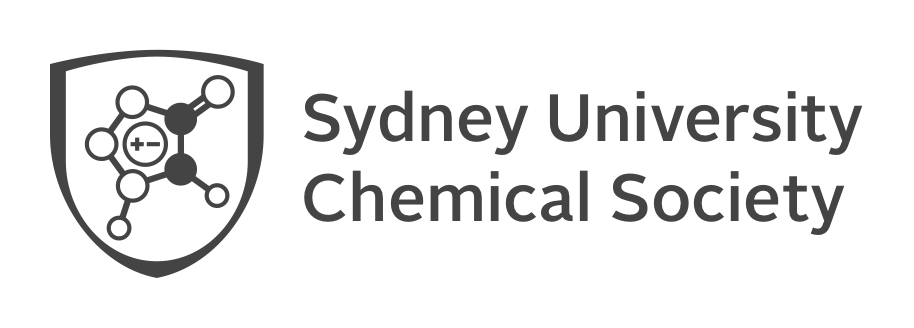Dr Shane Wilkinson
Shane is an education-focused lecturer in the Chemical Education and Communication Research (CECR) theme and the current director of the first-year teaching laboratories. His research interests focus on laboratory pedagogy and the use of augmented reality (AR) as a tool in chemical education.
How COVID changed the first year teaching laboratories
During this return-to-campus period, it was immediately obvious the impact that the pandemic had on the prior training of our students. The lack of high school laboratory experience, as a result of the lockdowns, presented students with skill deficiencies (even just handling glassware), cognitive overload and a lack of confidence.

Figure 1: The newly renovated First Year Chemistry Teaching Laboratories.
In March 2020, the refurbishment of half of the First Year Teaching laboratories was completed (Figure 1); with an additional 6 fumehoods added to each lab, wheelchair accessible fumehoods and lab benches, long-awaited air-conditioning, and future provisions for laboratory computing and AV. A month later, instead of being filled with thousands of bright-eyed First Year chemistry students, they laid barren as NSW went into the first of a number COVID-19 lockdowns.
The COVID-19 pandemic saw drastic changes to the way we taught Chemistry. Zoom classes replaced lectures and tutorials and the final exams moved online and were either open book or invigilated by web browser lockdowns and/or face-and-device recognition software. But finding a suitable replacement for the teaching and assessment of practical skills in the teaching laboratories was not as straightforward. Initial online transitions for most teaching laboratories around the globe focused on experiment recordings and providing students with experiment data to analyse. However, these “dry labs” focussed more on the interpretation of experiment results and did little in training students in the laboratory techniques involved to collect this data. To address this deficiency, we changed our approach to laboratory pedagogy. Being incapable of physically teaching these fundamental laboratory skills during lockdown, we had to apply a more theoretical approach. Instead of training in the technique procedures, we instead focused on why certain steps were important or why they were performed in a particular order. This was supplemented with laboratory technique simulations (LearnSci Lab Simulation Software) which allowed students to virtually conduct the laboratory techniques who then received instant feedback if they deviated from the correct technique sequence. A deeper understanding behind each technique was also delivered by focussing on the chemical concepts exploited in each technique, eg the success of liquid-liquid extraction relies on a knowledge of polarity, density, solubility, and acid/base properties.
The assessment of laboratories also shifted during the pandemic. Being unable to witness students’ competency in the lab, we introduced four authentic assessments that assessed students’ understanding of their experiment results in a real-world scenario. In addition, each assessment was presented as different assessment types to showcase the various forms of science communication. The assessment types included a technical report, professional letter to the EPA, a 3-minute video and an infographic. Each assessment was tied to an experiment completed in the laboratory program. For example, an experiment where students explored the UV-Vis spectroscopy of commercial sunscreens was linked to a “consumer information infographic” assignment (Figure 2) that required students to explain their experiment results and recommend a brand of sunscreen based on their scientific data. Students only needed to complete one of the four authentic assessments meaning students had to choose which experiment or assessment type they preferred to complete. Surveys found that some students preferred the systematic structure of the technical report whilst others relished the creative freedom of the video or infographic assessment. It was clear that the students appreciated the power to choose their assessment type and we now had a laboratory program that not only assessed students remotely, but could cater to the diverse cohort of students in first year chemistry.

Figure 2: Student infographic submission outlining the best sunscreen based on UV-Vis spectroscopic analysis.
As the lockdowns lifted, students were permitted to attend labs despite many lectures remaining online. However, social distancing and capacity restrictions meant we could not return to a full on-campus laboratory operation. Travel restrictions also meant that many of our overseas students were not able to enter the country and participate in the lab program. As a result, we ran a hybrid lab program which saw half of our local students alternating between on-campus laboratories and remote lab sessions still. During this return-to-campus period, it was immediately obvious the impact that the pandemic had on the prior training of our students. The lack of high school laboratory experience, as a result of the lockdowns, presented students with skill deficiencies (even just handling glassware), cognitive overload and a lack of confidence. This resulted in students being unable to complete traditional lab experiments within the time period of their three-hour laboratory session. To combat this, we introduced new technique-focused laboratory sessions into the program that ran like tutorials – so we coined them “labtorials” (laboratory tutorials). They operated as a flipped classroom teaching model; utilising both online material and on-campus training. Students would complete the same online laboratory technique modules used during the lockdowns, in their own time, to learn the theory behind the techniques used in the laboratory. Students would then attend a dedicated 90 minute on-campus lab session that focused purely on teaching the correct laboratory techniques. The techniques focussed on during each labtorial would tie in with an experiment the students were scheduled to complete in the following week. For example, the labtorial preceding the experiment on the “titration of vinegar” would focus on preparing standard solutions, quantitative transfers (weighing-by-difference, volumetric pipettes) and using a burette. The introduction of “labtorials” to the first-year laboratory program has seen students completing some experiments quicker than during the pre-COVID lab classes. Demonstrators have noted the improved performance of students in experiments following these labtorials. Students were generally more self-reliant meaning they required less assistance, explanations, and time to complete the lab experiment.
Fast forward to today: a choice of authentic assessments, and the inclusion of labtorial classes, have become a permanent fixture in our CHEM1A laboratory program. In fact, students are now graded (pass-fail) by demonstrating competency in each laboratory technique during their on-campus labtorial class. Demonstrators capture these grades live in class using Apple iPad minis. These labtorial assessments have ensured our students are passing their course based on both theory and practical competency. Furthermore, these labtorial assessments uphold the integrity of our coursework as they are unaffected by the current plague of artificial intelligence (eg ChatGPT) currently affecting many assessments across the University. Subsequently, the laboratory component of our first-year chemistry courses has increased (to 25%) which has reduced the weighting on the final exams (and reduced the pressure on our first-year students).
Whilst some of these changes to the lab program were devised before the COVID pandemic, I am certain that the lockdowns catalysed their roll out and influenced the creation of others. The changes introduced to the First Year Chemistry Laboratories during the COVID pandemic have greatly improved the laboratory program. Students are now being assessed in the laboratories through a combination of theoretical and practical authentic assessments. Additionally, the choice of authentic assessments has empowered students to take responsibility of their own learning and caters for the diverse applications and disciplines that Chemistry integrates itself into.
